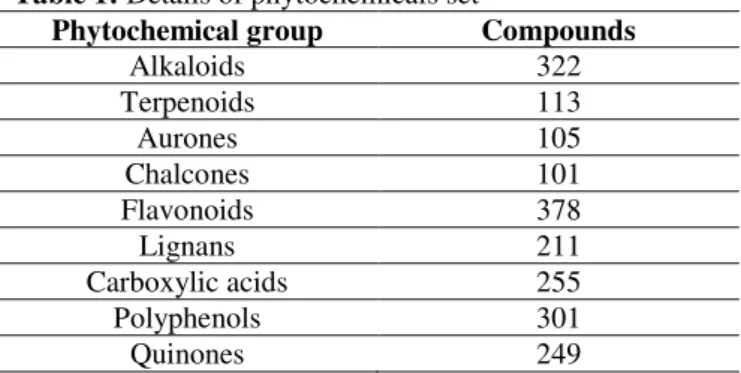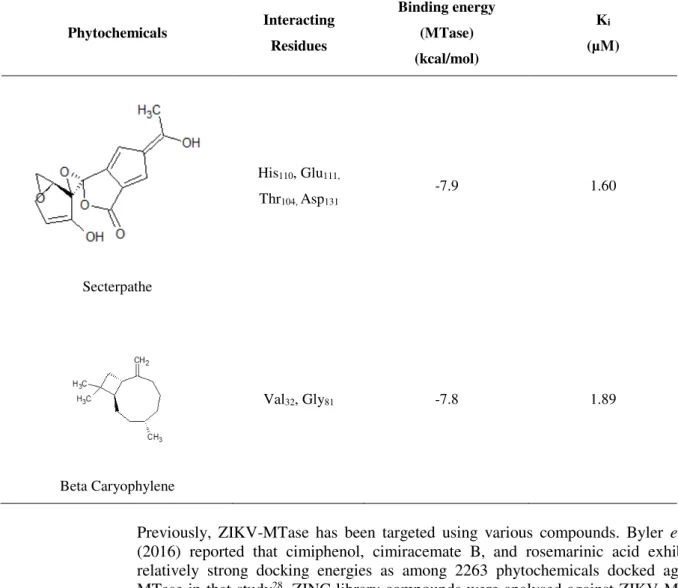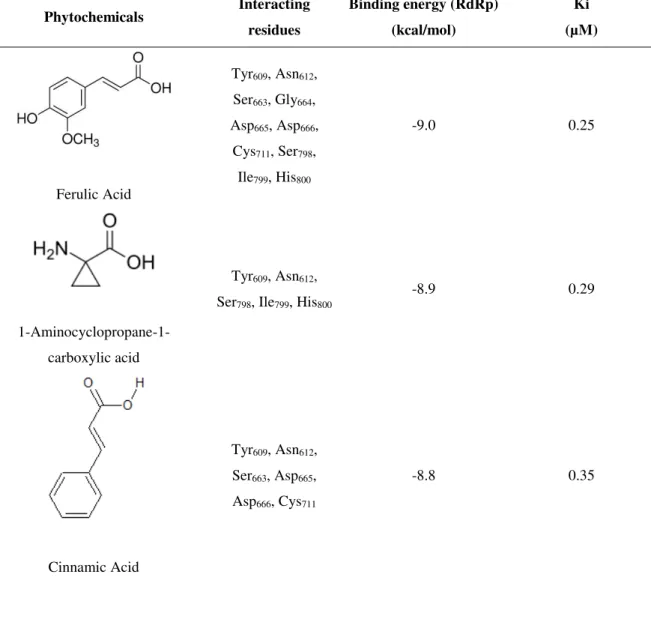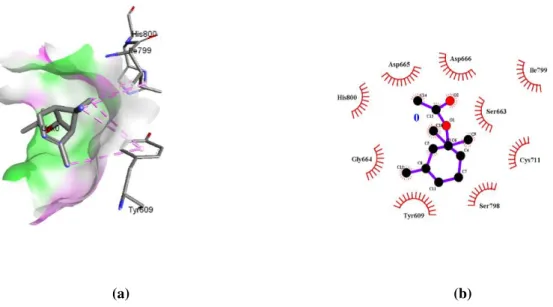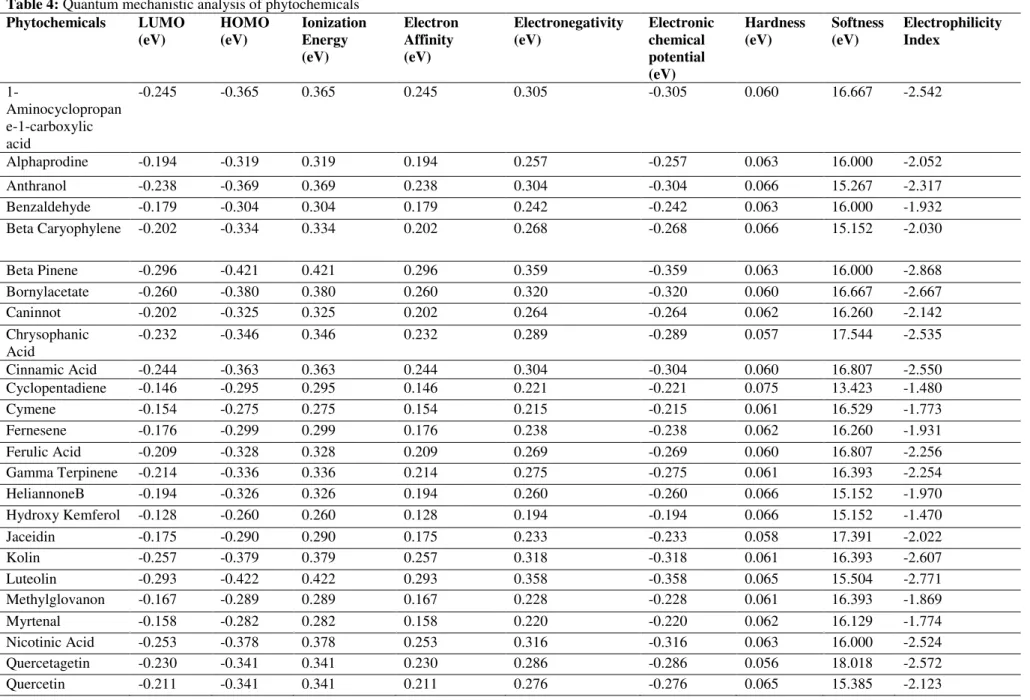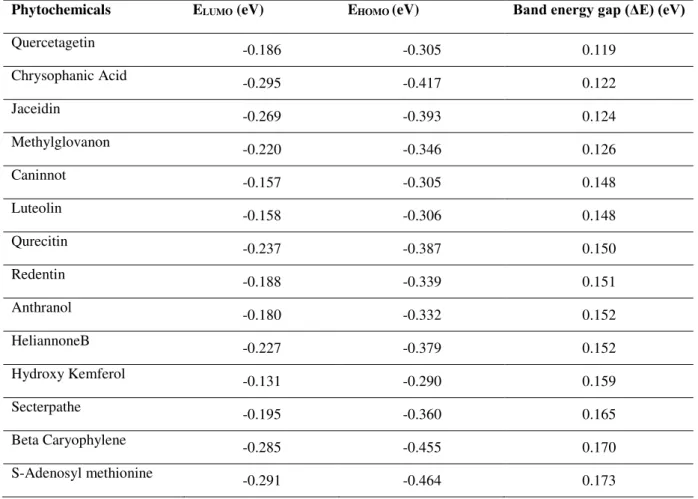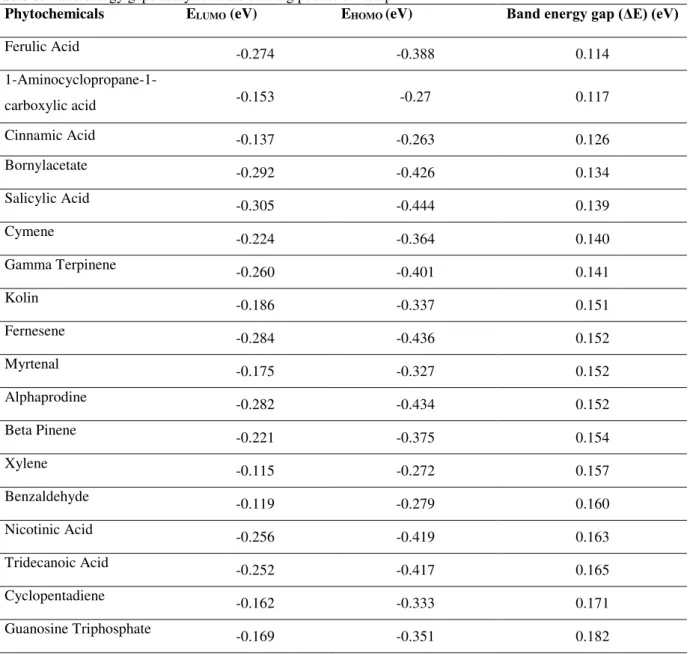ISSN 1678-4324 Online Edition
BIOLOGY AND TECHNOLOGY
A N I N T E R N A T I O N A L J O U R N A L
Probing the Pharmacological Parameters, Molecular
Docking and Quantum Computations of Plant Derived
Compounds Exhibiting Strong Inhibitory Potential Against
NS5 from Zika Virus
Nouman Rasool
1,2*, Amir Jalal
3, , Adnan Amjad
4, , Waqar Hussain
51 University of Management and Technology - Department of Life Sciences, Lahore, Pakistan ;2 Dr Panjwani Center for Molecular Medicine and Drug Research, International Center for Chemical and Biological Sciences, University of Karachi, Karachi, 75270, Pakistan; 3Sahara Medical College Narowal Pakistan; 4 University of Management and Technology - Department of Chemistry, Lahore, Pakistan.; 5 University of Management and Technology - Department of Computer Science, Lahore, Pakistan
ABSTRACT
Zika virus (ZIKV) is known for microcephaly and neurological disease in humans and the nonstructural proteins of ZIKV play a fundamental role in the viral replication. Among the seven nonstructural proteins, NS5 is the most conserved and largest protein. Two major functional domains of NS5 i.e. methyltransferase (MTase) and RNA-dependent RNA polymerase (RdRp) are imperative for the virus life cycle and survival. The present study explicates the inhibitory action of phytochemicals from medicinal plants against NS5 from ZIKV, leading to the identification of potential inhibitors. The crystal structure of the protein is retrieved from RCSB protein data bank. A total of 2035 phytochemicals from 505 various medicinal plants are analysed for their pharmacological properties and pharmacokinetics. Compounds having effective drug-likeness are docked against the protein and further analysed using density functional theory approach. Among the 2035 phytochemicals, 13 are selected as potential inhibitors against MTase having high binding affinities and 17 compounds are selected for RdRp. HOMO and LUMO energies are calculated for the docked compounds within and outside binding pockets of MTase and RdRp, adapting the B3LYP hybrid exchange-correlation functional with def2-SV(P) basis set. Physicochemical properties such as ionization energy, electronic chemical potential, electronegativity, electron affinity, molecular softness, molecular hardness and electrophilicity index have also been analysed for selected phytochemicals. Based upon the results, it is concluded that the selected phytochemicals are highly competent to impede the replication of the virus by inhibiting the ZIKV-NS5.
Keywords: ZIKV-NS5; Phytochemicals; Molecular Docking; DFT calculations;
INTRODUCTION
Zika infection has emerged as a severe threat to human as it leads to critical, although rare, issues including microcephaly and neurological disease1. The source of this infection is Zika virus (ZIKV) which is an arbovirus and belongs to the genus
Flavivirus of the family Flaviviridae2. Transmission of ZIKV is carried out through
Aedes spp. mosquitoes including Ae. Apicoargenteus, Ae. africanus, Ae. aegypti, Ae. furcifer, Ae. hensilli, Ae. luteocephalus, and Ae. vitattus. The sexual transmission of disease is also possible as the replicative ZIKV is observed to be found in the semen of an infected man3. Furthermore, it is known to be transmitted through perinatal and trans-placental ways as the RNA of ZIKV is detected in the amniotic fluids samples from the fetuses of infected mothers. The infections associated with ZIKV are typically characterized by maculopapular rash, headache, fever, myalgia and conjunctivitis4.
The genome of ZIKV is a single stranded positive sense RNA which translates into a single polypeptide5. The polypeptide is truncated into ten proteins classified as structural and nonstructural proteins. Among those ten proteins, there are three structural proteins i.e. Envelope (E), Membrane (M) and Capsid (C) and seven nonstructural proteins i.e. NS1, NS2A, NS2B, NS3, NS4A, NS4B and NS56.
MATERIAL AND METHODS
The structures of NS5 MTase and RdRp domains were retrieved from Protein Data Bank (PDB ID: 5M5B and 5U04, respectively). A total of 2035 plant-derived phytochemicals were analysed in this study (Table 1). The compounds belonged to a variety of medicinal plants of Pakistan and India. These compounds were searched from literature review and structures were retrieved from PubChem. Initial screening was based on pharmacologic and pharmacokinetic properties to select BBB-permeable compounds. Screened compounds are docked and interactions are analysed for potentially inhibiting compounds. Molecular orbital energies based physiochemical properties are also analysed for these compounds, within and outside the pocket of proteins.
Table 1: Details of phytochemicals set
Phytochemical group Compounds
Alkaloids 322
Terpenoids 113
Aurones 105
Chalcones 101
Flavonoids 378
Lignans 211
Carboxylic acids 255
Polyphenols 301
Quinones 249
Assessing pharmacological properties of phytochemicals
Pharmacological properties i.e. Absorption, Distribution, Metabolism and Excretion along with the prediction of Toxicity were used for screening the phytochemicals. These parameters also helped in evaluating the drug likeness effective disposition of the phytochemicals in the human body. The prediction of ADME profiles was carried out using SwissADME web server14. Toxicity and the Drug likeness was predicted using the PreADMET server15.
Molecular docking and validation of results
The docking study was performed to analyse the inhibition role of phytochemicals against both domains of NS5 protein i.e. MTase and RdRp. The ligand and protein preparation was performed in AutoDock Tools and docking was performed using AutoDock Vina16,17. The interactions of the compounds were analysed along with the estimation of binding energies and for further analysis of docking, Ki was calculated by the equation:
𝑲
𝒊= 𝒆
∆𝑮 𝑹 𝒙 𝑻Where ΔG is docking energy, R (gas constant) is 1.9872036 cal/mol and T (temperature) is 298.15K. For validation of results and selection of potential inhibitors, natural ligands of both domains i.e. Guanosine Triphosphate (GTP) and S-Adenosyl methionine (SAM) were docked with RdRp and MTase, respectively; and binding energies were compared. Compounds showing strong binding affinity as compared to the known ligands were further analysed for DFT analysis.
Lowest Unoccupied Molecular Orbital (LUMO) and Highest Occupied Molecular Orbital (HOMO) energies of the phytochemicals were calculated using ORCA program by applying the Becke3-Lee-Yang-Parr (B3LYP) hybrid functional exchange correlation of DFT to estimate the ionization energy, electronic chemical potential, electronegativity, electron affinity, molecular softness, molecular hardness and electrophilicity index18. For these calculations, following equations were used.
𝐼𝑜𝑛𝑖𝑧𝑎𝑡𝑖𝑜𝑛 𝑒𝑛𝑒𝑟𝑔𝑦 (𝐼𝐸) = − 𝜖𝐻𝑂𝑀𝑂
𝐸𝑙𝑒𝑐𝑡𝑟𝑜𝑛 𝑎𝑓𝑓𝑖𝑛𝑖𝑡𝑦 (𝐸𝐴) = − 𝜖𝐿𝑈𝑀𝑂
𝐸𝑙𝑒𝑐𝑡𝑟𝑜𝑛𝑒𝑔𝑎𝑡𝑖𝑣𝑖𝑡𝑦 (𝜒) = (𝐼𝐸 + 𝐸𝐴)2 𝐸𝑙𝑒𝑐𝑡𝑟𝑜𝑛𝑖𝑐 𝑐ℎ𝑒𝑚𝑖𝑐𝑎𝑙 𝑝𝑜𝑡𝑒𝑛𝑡𝑖𝑎𝑙 (𝜇) = −𝜒
𝐶ℎ𝑒𝑚𝑖𝑐𝑎𝑙 ℎ𝑎𝑟𝑑𝑛𝑒𝑠𝑠 (𝜂) = (𝐼𝐸 − 𝐸𝐴)2
𝐶ℎ𝑒𝑚𝑖𝑐𝑎𝑙 𝑠𝑜𝑓𝑡𝑛𝑒𝑠𝑠 (𝜎) = 1𝜂
𝐸𝑙𝑒𝑐𝑡𝑟𝑜𝑝ℎ𝑖𝑙𝑖𝑐𝑖𝑡𝑦 𝑖𝑛𝑑𝑒𝑥 (𝜔) = 2𝜂𝜇
The targeted hybrid exchange correlation i.e. B3LYP is defined as:
𝐸𝑥𝑐𝐵3𝐿𝑌𝑃= 𝐸𝑥𝐿𝐷𝐴+ 𝑎0 (𝐸𝑥𝐻𝐹− 𝐸𝑥𝐿𝐷𝐴) + 𝑎𝑥 (𝐸𝑥𝐺𝐺𝐴− 𝐸𝑥𝐿𝐷𝐴) + 𝐸𝑐𝐿𝐷𝐴
+ 𝑎𝑐 (𝐸𝑐𝐺𝐺𝐴− 𝐸𝑐𝐿𝐷𝐴)
Where 𝑎0= 0.20, 𝑎𝑥 = 0.72, and 𝑎𝑐 = 0.81. 𝐸𝑥𝐺𝐺𝐴 is actually the generalized gradient approximation for the Becke 88 functional while the 𝐸𝑐𝐺𝐺𝐴 reflects the correlation functional of Lee-Yang-Parr. 𝐸𝑐𝐿𝐷𝐴 is the local density approximation. To analyse the reactivity of phytochemicals in the binding pocket of MTase and RdRp, band energy gaps were calculated using the expression ELUMO-EHOMO19,20. Phytochemicals along with the interacting residues from binding pocket were considered for the calculations and for each phytochemical, the conformer with maximum binding energy was analysed.
RESULTS AND DISCUSSION
ZIKV infection is an evolving threat to humans and has long term detrimental effects in terms of microcephaly, male sterility and neurological disease. The inhibition of ZIKV is one of the major concerns of the clinical and scientific community. Tertiary structure of ZIKV-NS5 reveals an N-terminal MTase domain, situated at the top of C-terminal RdRp domain. A Rossmann fold dominates the MTase domain with a seven stranded β-sheet, between two α-helices21. To find the potential inhibitors, a total of 2035 phytochemicals were analysed for in this study for their inhibitory potential against ZIKV-NS5.
Pharmacological properties of phytochemicals
All 2035 compounds were analysed for their pharmacological properties and pharmacokinetics. Properties being analysed included solubility, gastrointestinal (GI)
absorption, blood brain barrier (BBB) permeability, Lipinski’s rules violation
and toxicity. The criteria set for selecting suitable compounds was:
(BBB-permeability = Yes) & (Solubility = High) & (GI-absorption = High) &
At each level of criteria set, the number of compounds selected for further analysis was reduced. Initially, out of 2035 phytochemicals, only 720 were BBB permeable. Due to the association of ZIKV with neuronal infection, it was necessary to select only those compounds which can penetrate through BBB22. From those 720 compounds, only 344 had high solubility and GI absorption. Among 344 compounds, 280 violated no rule of Lipinski and at the end, only 153 were left as non-toxic phytochemicals (Table S1). All of these parameters are necessary to evaluate the drug-likeness of a compound and helps in assessing the effective disposition of compounds in the human body23-26.
Analysis of dockings and interactions
153 compounds, screened on the basis of pharmacological properties, were docked against both the domains of ZIKV NS5 i.e. MTase and RdRp. SAM and GTP were docked against MTase and RdRp, respectively, as they both are reported as natural ligands of the MTase and GTP27. SAM docked with MTase having a binding affinity of -7.7 kcal/mol (Ki = 2.24 µM) whereas binding affinity of GTP was -6.9 kcal/mol (Ki = 8.64 µM) against RdRp. From 153 phytochemicals, 13 phytochemicals showed binding affinity greater than or equal to -7.7 kcal/mol against MTase and 17 phytochemicals showed binding affinity greater than -6.9 kcal/mol against RdRp.
Docking phytochemicals against MTase
153 compounds were docked against MTase and 13 showed binding affinity greater than the binding affinity of SAM, a natural ligand for MTase domain of NS5. Results showed that Quercetagetin, a flavonol, docked with viral enzyme having a binding affinity -10.9 kcal/mol (Ki = 0.01 µM) which is greater than affinities of all other compounds (Table 2). The compound docked in the binding pocket of MTase interacted with Val30, Val32, His110 and His111 (Fig. 1). Chrysophanic Acid (a quinone) and Jaceidin (a flavonoid) also docked with good binding affinities i.e. -10.2 kcal/mol (Ki = 0.03 µM) and -10.1 kcal/mol (Ki = 0.04 µM), respectively. Chrysophanic acid interacted with Val30, Val32 and Ile147 at the binding pocket of MTase while Gly81, Asp146 and Phe133 were involved in the interactions with Jaceidin.
Table 2: Phytochemicals strongly inhibiting ZIKV-MTase
Phytochemicals Interacting Residues
Binding energy
(MTase)
(kcal/mol)
Ki
(µM)
Quercetagetin
Val30, Val32,
His110, Glu111
Phytochemicals Interacting Residues
Binding energy
(MTase)
(kcal/mol)
Ki
(µM)
Chrysophanic Acid
Val30, Val32, Ile147 -10.2 0.03
Jaceidin
Gly81, Asp146,
Phe133
-10.1 0.04
Methylglovanon
Lys105, Asp131,
Ile147
-9.5 0.11
Caninnot
Thr104, Asp131,
Phe133
-8.9 0.29
Luteolin
Val30, Gly81,
Glu111
Phytochemicals Interacting Residues
Binding energy
(MTase)
(kcal/mol)
Ki
(µM)
Quercetin
His110, Glu111,
Asp131
-8.6 0.49
Redentin
Val30, Val32,
Phe133
-8.6 0.49
Anthranol
Lys105, Phe133,
Ile147
-8.4 0.69
HeliannoneB
Gly81, Asp146,
Ile147
-8.4 0.69
Hydroxy Kemferol
Phytochemicals Interacting Residues
Binding energy
(MTase)
(kcal/mol)
Ki
(µM)
Secterpathe
His110, Glu111,
Thr104, Asp131
-7.9 1.60
Beta Caryophylene
Val32, Gly81 -7.8 1.89
Previously, ZIKV-MTase has been targeted using various compounds. Byler et al., (2016) reported that cimiphenol, cimiracemate B, and rosemarinic acid exhibited relatively strong docking energies as among 2263 phytochemicals docked against MTase in that study28. ZINC library compounds were analysed against ZIKV-MTase and results of docking were compared with BG323, a known inhibitor of MTase. It is reported that ZINC64717952 showed high binding affinity against MTase as compared to that of BG3233.
(a) (b)
Figure 1: Interaction of Quercetagetin within binding pocket of ZIKV MTase (a) 3D view of pocket (b)
Docking phytochemicals against RdRp
Among all 153 compounds docked against RdRp, 17 showed binding affinity greater than the binding affinity of GTP, a natural ligand for RdRp domain of NS5. Results showed that Ferulic Acid, a phenol, docked with binding affinity -9.0 kcal/mol, greater than affinities of all other compounds (Table 3). The compound docked in the binding pocket of RdRp interacting with Tyr609, Ile799 and His800 (Fig. 2). 1-Aminocyclopropane-1-carboxylic acid and Cinnamic acid, both carboxylic acids in nature, docked with binding affinities -8.9 kcal/mol (Ki = 0.29 µM) and -8.8 kcal/mol (Ki = 0.35 µM), respectively. 1-Aminocyclopropane-1-carboxylic acid interacted with Tyr609, Asn612, Ser798, Ile799 and His800 residues at the RNA tunnel of ZIKV-RdRp. Moreover, Cinnamic acid docked at the RNA tunnel of RdRp by interacting with Tyr609, Asn612, Ser663, Asp665, Asp666 and Cys711.
Table 3: Phytochemicals strongly inhibiting ZIKV-RdRp
Phytochemicals Interacting residues
Binding energy (RdRp)
(kcal/mol)
Ki
(µM)
Ferulic Acid
Tyr609, Asn612,
Ser663, Gly664,
Asp665, Asp666,
Cys711, Ser798,
Ile799, His800
-9.0 0.25
1-Aminocyclopropane-1-carboxylic acid
Tyr609, Asn612,
Ser798, Ile799, His800
-8.9 0.29
Cinnamic Acid
Tyr609, Asn612,
Ser663, Asp665,
Asp666, Cys711
Phytochemicals Interacting residues
Binding energy (RdRp)
(kcal/mol)
Ki
(µM)
Bornylacetate
Gly664, Asp665,
Asp666, Cys711,
Ser798, His800
-8.6 0.49
Salicylic Acid
Cys711, Ser712,
Trp797, Ile799
-8.5 0.58
Cymene
Met660, Ala661,
Val662, Cys711,
Ser798
-8.4 0.69
Gamma Terpinene
Tyr609, Ile799,
His800
-8.4 0.69
Kolin
Ser663, Gly664,
Asp665, Cys711,
Ser798
Phytochemicals Interacting residues
Binding energy (RdRp)
(kcal/mol)
Ki
(µM)
Fernesene
Asp666, Cys667,
Val668, Ser798,
His800
-8.0 1.35
Myrtenal
Met660, Val662,
His800
-8.0 1.35
Alphaprodine
Asn612, Gly664,
Thr796
-7.9 1.60
Beta Pinene
Asn612, Gly664,
Thr796
-7.9 1.60
Xylene
Val662, Cys711,
Ser798
Phytochemicals Interacting residues
Binding energy (RdRp)
(kcal/mol)
Ki
(µM)
Benzaldehyde
Asn612, Asp666,
Cys711, Ser798
-7.6 2.65
Nicotinic Acid
Glu509, Gly664,
Thr796
-7.5 3.14
Tridecanoic Acid
Gly507, Val508 -7.4 3.71
Cyclopentadiene
(a) (b)
Figure 2: Interaction of Ferulic Acid within RNA Tunnel of ZIKV RdRp (a) 3D view of pocket (b) Interaction plot
ZIKV-RdRp is a potential target for drug discovery as RdRp enzyme or its analogue structure in the human body are not present, therefore the inhibitors of this enzyme do not cause any toxicity in the body by interacting with any other enzyme9. In a previous study, Prenylatedchalcone, 2’,4,4’-trihydroxy-3,3’-diprenylchalcone, bisindole and flinderoleB are reported to potentially inhibit ZIKV-RdRp domain with strong binding affinities. Among 2263 phytochemicals, these four compounds were screened based on high binding energies28. While targeting this enzyme with ZINC library, it was observed that ZINC39563464 showed the strong binding affinity to RdRp. The score was also higher as compared to that of Ribavirin, a potential inhibitor of RdRp3. In the present study, Quercetagetin was docked with MTase, having highest binding affinity as compared to that of all other compounds, however, in another study, Quercetagetin was reported as inhibitor of HCV-NS5B, which is also an RdRp29. This illustrates that Quercetagetin showed binding affinity < -6.9kcal/mol when docked with ZIKV-RdRp.
Quantum mechanistic analysis of selected 30 compounds
Table 4: Quantum mechanistic analysis of phytochemicals
Phytochemicals LUMO (eV) HOMO (eV) Ionization Energy (eV) Electron Affinity (eV) Electronegativity (eV) Electronic chemical potential (eV) Hardness (eV) Softness (eV) Electrophilicity Index 1-Aminocyclopropan e-1-carboxylic acid
-0.245 -0.365 0.365 0.245 0.305 -0.305 0.060 16.667 -2.542
Alphaprodine -0.194 -0.319 0.319 0.194 0.257 -0.257 0.063 16.000 -2.052
Anthranol -0.238 -0.369 0.369 0.238 0.304 -0.304 0.066 15.267 -2.317
Benzaldehyde -0.179 -0.304 0.304 0.179 0.242 -0.242 0.063 16.000 -1.932
Beta Caryophylene -0.202 -0.334 0.334 0.202 0.268 -0.268 0.066 15.152 -2.030
Beta Pinene -0.296 -0.421 0.421 0.296 0.359 -0.359 0.063 16.000 -2.868
Bornylacetate -0.260 -0.380 0.380 0.260 0.320 -0.320 0.060 16.667 -2.667
Caninnot -0.202 -0.325 0.325 0.202 0.264 -0.264 0.062 16.260 -2.142
Chrysophanic Acid
-0.232 -0.346 0.346 0.232 0.289 -0.289 0.057 17.544 -2.535
Cinnamic Acid -0.244 -0.363 0.363 0.244 0.304 -0.304 0.060 16.807 -2.550
Cyclopentadiene -0.146 -0.295 0.295 0.146 0.221 -0.221 0.075 13.423 -1.480
Cymene -0.154 -0.275 0.275 0.154 0.215 -0.215 0.061 16.529 -1.773
Fernesene -0.176 -0.299 0.299 0.176 0.238 -0.238 0.062 16.260 -1.931
Ferulic Acid -0.209 -0.328 0.328 0.209 0.269 -0.269 0.060 16.807 -2.256
Gamma Terpinene -0.214 -0.336 0.336 0.214 0.275 -0.275 0.061 16.393 -2.254
HeliannoneB -0.194 -0.326 0.326 0.194 0.260 -0.260 0.066 15.152 -1.970
Hydroxy Kemferol -0.128 -0.260 0.260 0.128 0.194 -0.194 0.066 15.152 -1.470
Jaceidin -0.175 -0.290 0.290 0.175 0.233 -0.233 0.058 17.391 -2.022
Kolin -0.257 -0.379 0.379 0.257 0.318 -0.318 0.061 16.393 -2.607
Luteolin -0.293 -0.422 0.422 0.293 0.358 -0.358 0.065 15.504 -2.771
Methylglovanon -0.167 -0.289 0.289 0.167 0.228 -0.228 0.061 16.393 -1.869
Myrtenal -0.158 -0.282 0.282 0.158 0.220 -0.220 0.062 16.129 -1.774
Redentin -0.292 -0.423 0.423 0.292 0.358 -0.358 0.066 15.267 -2.729
Salicylic Acid -0.160 -0.281 0.281 0.160 0.221 -0.221 0.061 16.529 -1.822
Secterpathe -0.197 -0.329 0.329 0.197 0.263 -0.263 0.066 15.152 -1.992
Tridecanoic Acid -0.272 -0.421 0.421 0.272 0.347 -0.347 0.075 13.423 -2.326
Among all the compounds, Quercetagetin showed the most effective properties i.e. hardness (0.056 kcal/mol), electrophilicity index (-2.572 kcal/mol) and electronic chemical potential (-0.286 kcal/mol). Chemical hardness of a compound illustrates its stability and reactivity. The larger band energy gaps reflect hardness and stability of the compounds but leads to lower reactivity. Smaller band energy gaps reflect softness and high reactivity of compounds. The electronic chemical potential is actually the negative value of electronegativity and the greater electronic chemical potential reflects less stability and high reactivity of the compounds. The mechanism and capacity of electrons acceptance is measured through electrophilicity index30,31. It measures the stabilization in energy after the chemical reaction through electron acceptance and donation32. Such analysis has been previously conducted by Gopalakrishnan et al., (2014) to analyse the phytochemical constituents of the
Cucumis trigonus and Cucumis sativus33.
For analysing reactivity, phytochemicals and the binding pocket residues was the point of interest for energy calculations. The quantum mechanistic analysis was carried out on the ligand-NS5 domain conformation selected in the docking analysis. Results revealed that Quercetagetin was most reactive compound within binding pocket of NS5 as band energy gap was narrow as compared to others i.e. 0.119 eV, while the natural ligand i.e. SAM showed least reactivity as band energy gap was 0.173eV, lowest among all the other 13 compounds (Table 5). For RdRp domain, Ferulic Acid had the narrow band energy gap i.e. 0.114 eV reflecting its higher reactivity potential with the binding pocket residues of RdRp, while the natural ligand i.e. GTP showed least reactivity as band energy gap was 0.182eV, lowest among all the other 17 compounds (Table 6).
Table 5: Band energy gaps analysis in the binding pocket of MTase
Phytochemicals ELUMO (eV) EHOMO (eV) Band energy gap (ΔE) (eV)
Quercetagetin
-0.186 -0.305 0.119
Chrysophanic Acid
-0.295 -0.417 0.122
Jaceidin -0.269 -0.393 0.124
Methylglovanon -0.220 -0.346 0.126
Caninnot
-0.157 -0.305 0.148
Luteolin
-0.158 -0.306 0.148
Qurecitin
-0.237 -0.387 0.150
Redentin
-0.188 -0.339 0.151
Anthranol -0.180 -0.332 0.152
HeliannoneB -0.227 -0.379 0.152
Hydroxy Kemferol
-0.131 -0.290 0.159
Secterpathe
-0.195 -0.360 0.165
Beta Caryophylene
-0.285 -0.455 0.170
S-Adenosyl methionine
Table 6: Band energy gaps analysis in the binding pocket of RdRp
Phytochemicals ELUMO (eV) EHOMO (eV) Band energy gap (ΔE) (eV)
Ferulic Acid -0.274 -0.388 0.114
1-Aminocyclopropane-1-carboxylic acid -0.153 -0.27 0.117
Cinnamic Acid -0.137 -0.263 0.126
Bornylacetate -0.292 -0.426 0.134
Salicylic Acid -0.305 -0.444 0.139
Cymene
-0.224 -0.364 0.140
Gamma Terpinene
-0.260 -0.401 0.141
Kolin
-0.186 -0.337 0.151
Fernesene
-0.284 -0.436 0.152
Myrtenal -0.175 -0.327 0.152
Alphaprodine -0.282 -0.434 0.152
Beta Pinene
-0.221 -0.375 0.154
Xylene
-0.115 -0.272 0.157
Benzaldehyde
-0.119 -0.279 0.160
Nicotinic Acid
-0.256 -0.419 0.163
Tridecanoic Acid -0.252 -0.417 0.165
Cyclopentadiene -0.162 -0.333 0.171
Guanosine Triphosphate
-0.169 -0.351 0.182
CONCLUSION
The infection associated with ZIKV leads to long term effects in terms of various diseases, specifically neurological ones. The Zika infection is an emerging threat and no clinically approved antiviral treatment is discovered yet to cure the disease. Computational approaches for drug development are proven to be effective and time efficient as these are not based on costly and hectic laborious works. In drug discovery, the molecular dynamics simulations help in the study of the motions of biological macromolecules such as proteins and nucleic acids. Computational mechanisms of biological targets and their associated small-molecule ligands can play an important role in drug discovery; including the identification of binding sites, virtual screening of numerous compounds libraries and estimation of ligand binding energies. The docking of inhibitors with the enzymes elucidate the mechanism of inhibition along with the specificity and efficiency of that inhibitor. It was aim of the present study to identify potential inhibitors of the virus replication and the most fundamental protein i.e. NS5 was targeted in this study using 2053 plant derived compounds. The successfully docked compounds with high binding affinity and reactivity are reported against both the domains of NS5 i.e. MTase and RdRp. These are all BBB-permeable and can reach the central nervous system as ZIKV targets the neuronal cells. Due to higher affinities and reactivity of these compounds against NS5, these 30 compounds have potential inhibitory activity against ZIKV and can be further analysed using in vitro and in vivo approach to elucidate their inhibitory mechanism against ZIKV.
REFERENCES
1. Hayes EB. Zika virus outside Africa. Emerg Infect Dis. 2009; 15: 1347.
2. Shi PY. Molecular virology and control of flaviviruses. Horizon Scientific Press; 2009 3. Ramharack P, Soliman ME. Zika virus NS5 protein potential inhibitors: an enhanced in silico approach in drug discovery. J Biomol Struct Dyn. 2017; 1-16.
4. Musso D, Nilles EJ, Cao-Lormeau VM. Rapid spread of emerging Zika virus in the Pacific area. Clin Microbiol Infect. 2014; 20: O595-O596.
5. Campos GS, Bandeira AC, Sardi SI. Zika virus outbreak, Bahia, Brazil. Emerg Infect Dis. 2015; 21: 1885.
6. Haddow AD, Schuh AJ, Yasuda CY, Kasper MR, Heang V, Huy R, Weaver SC. Genetic characterization of Zika virus strains: geographic expansion of the Asian lineage. PLoS Negl Trop Dis. 2012; 6: e1477.
7. Zou XW, Liu YC, Hsu NS, Huang CJ, Lyu SY, Chan HC, Tsai MD. Structure and mechanism of a nonhaem-iron SAM-dependent C-methyltransferase and its engineering to a hydratase and an O-methyltransferase. Acta Crystallogr D Biol Crystallogr. 2014; 70:1549-1560.
8. Brecher M, Chen H, Liu B, Banavali NK, Jones SA, Zhang J, Li H. Novel broad spectrum inhibitors targeting the flavivirus methyltransferase. PLoS One. 2015; 10: e0130062. 9. Anusuya S, Velmurugan D, Gromiha MM. Identification of dengue viral RNA-dependent RNA polymerase inhibitor using computational fragment-based approaches and molecular dynamics study. J Biomol Struct Dyn. 2016; 34: 1512-1532.
10. Papageorgiou L, Loukatou S, Koumandou VL, Makałowski W, Megalooikonomou V,
11. Tang H, Hammack C, Ogden SC, Wen Z, Qian X, Li Y, Christian KM. Zika virus infects human cortical neural progenitors and attenuates their growth. Cell Stem Cell. 2016; 18: 587-590.
12. Williamson EM. Synergy and other interactions in phytomedicines. Phytomed. 2001; 8:401-410.
13. Briskin DP. Medicinal plants and phytomedicines. Linking plant biochemistry and physiology to human health. Plant Physiol. 2000; 124:507-14.
14. Daina A, Michielin O, Zoete V. SwissADME: a free web tool to evaluate pharmacokinetics, drug-likeness and medicinal chemistry friendliness of small molecules. Sci Rep 2017; 7:42717.
15. Lee SK, Lee IH, Kim HJ, Chang GS, Chung JE, No KT. The PreADME Approach: Web-based program for rapid prediction of physico-chemical, drug absorption and drug-like properties. EuroQSAR 2002 Designing Drugs and Crop Protectants: processes, problems and solutions. 2003; 418-20.
16. Hussain W, Qaddir I, Mahmood S, Rasool N. In silico targeting of non-structural 4B protein from dengue virus 4 with spiropyrazolopyridone: study of molecular dynamics simulation, ADMET and virtual screening. VirusDisease. 2018; 29:147-156.
17. Trott O, Olson AJ. AutoDock Vina: improving the speed and accuracy of docking with a new scoring function, efficient optimization, and multithreading. J Comp Chem. 2010; 31:455-61.
18. Neese F. The ORCA program system. Wiley Interdiscip Rev Comput Mol Sci. 2012; 2:73-8.
19. Qaddir I, Rasool N, Hussain W, Mahmood S. Computer-aided analysis of phytochemicals as potential dengue virus inhibitors based on molecular docking, ADMET and DFT studies. Journal of Vector Borne Diseases. 2017; 54:255.
20. Rasool N, Iftikhar S, Amir A, Hussain W. Structural and quantum mechanical computations to elucidate the altered binding mechanism of metal and drug with pyrazinamidase from Mycobacterium tuberculosis due to mutagenicity. Journal of molecular graphics & modelling. 2017; 80:126-31.
21. Wang B, Tan XF, Thurmond S, Zhang ZM, Lin A, Hai R, Song J. The structure of Zika virus NS5 reveals a conserved domain conformation. Nat Commun. 2017; 8.
22. Millichap J. Zika virus infection and microcephaly. Ped Neurol Briefs. 2016; 30.
23. Delaney JS. ESOL: estimating aqueous solubility directly from molecular structure. J Chem Inf Comput Sci. 2004; 44:1000-5.
24. Kimura T, Higaki K. Gastrointestinal transit and drug absorption. Biological and Pharm Bull. 2002; 25:149-64.
25. Lipinski CA, Lombardo F, Dominy BW, Feeney PJ. Experimental and computational approaches to estimate solubility and permeability in drug discovery and development settings. Adv Drug Deliv Rev. 1997; 23:3-25.
26. Tran N. Blood-Brain Barrier. Encyclopedia of Clinical Neuropsychology. Springer New York; 2011.
27. Godoy AS, Lima GM, Oliveira KI, Torres NU, Maluf FV, Guido RV, Oliva G. Crystal structure of Zika virus NS5 RNA-dependent RNA polymerase. Nat Commun. 2017; 8.
28. Byler KG, Ogungbe IV, Setzer WN. In-silico screening for anti-Zika virus phytochemicals. J Mol Graph Model. 2016; 69:78-91.
29. Ahmed-Belkacem A, Guichou JF, Brillet R, Ahnou N, Hernandez E, Pallier C, Pawlotsky JM. Inhibition of RNA binding to hepatitis C virus RNA-dependent RNA polymerase: a new mechanism for antiviral intervention. Nucleic Acids Research. 2014; 42:9399-409.
30. Parr RG, Szentpaly LV, Liu S. Electrophilicity index. J Am Chem Soc. 1999; 121: 1922-1924.
32. Liu S. Dynamic behavior of chemical reactivity indices in density functional theory: A Bohn-Oppenheimer quantum molecular dynamics study. J Chem Sci. 2005; 117: 477-483. 33. Gopalakrishnan SB, Kalaiarasi T, Subramanian R. Comparative DFT Study of Phytochemical Constituents of the Fruits of Cucumis trigonus Roxb. and Cucumis sativus Linn. J Comp Method Phy. 2014; 2014.
34. Gogoi D, Baruah VJ, Chaliha AK, Kakoti BB, Sarma D, Buragohain AK. Identification of novel human renin inhibitors through a combined approach of pharmacophore modelling, molecular DFT analysis and in silico screening. Comp Biol Chem. 2017; 69:28-40.
35. Kavitha R, Karunagaran S, Chandrabose SS, Lee KW, Meganathan C. Pharmacophore modeling, virtual screening, molecular docking studies and density functional theory approaches to identify novel ketohexokinase (KHK) inhibitors. BioSys. 2015; 138:39-52. 36. Eroglu E, Türkmen H. A DFT-based quantum theoretic QSAR study of aromatic and heterocyclic sulfonamides as carbonic anhydrase inhibitors against isozyme, CA-II. J Mol Graph Model. 2007; 26:701-8.
37. Ai C, Li Y, Wang Y, Li W, Dong P, Ge G, Yang L. Investigation of binding features: effects on the interaction between CYP2A6 and inhibitors. J Comp Chem. 2010; 31:1822-31.
